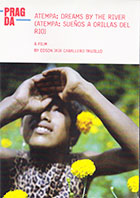
Atempa: Dreams by the River (Atempa: Suenos a la Orilla del Rio) 2013
Distributed by Pragda, 302 Bedford Ave., #136, Brooklyn, NY 11249
Produced by Edson J. Caballero Trujillo
Directed by Edson J. Caballero Trujillo
DVD , color, 85 min.
High School - General Adult
Latin America, Gender
Date Entered: 07/26/2017
Reviewed by Monique Threatt, Indiana University, Herman B Wells Library, Bloomington, INI applaud filmmaker Caballero Trujillo for presenting a semi-unique portrait of muxe culture in San Blas Atempa, Oaxaca, Mexico. Atempa: Dreams by the River documents gender empowerment and sexual identity as portrayed through the lives of Tino, a young muxe who dreams of becoming “Queen of the Gazelles,” Raciel, an adult muxe and mentor to Tino, and Maira, a single mother determined to fight patriarchal tyranny in exchange for municipal government with free elections.
San Blas is one of many municipalities in the district of Tehauntepec steeped in rich history, symbolism, and cultural pride. Locals believe that when the soul leaves the body, it crosses the river to travel the world leaving the body to remain in San Blas. The river is symbolically the threshold between life and death. San Blas is also a community where one-third of its population are muxes. Muxes are responsible and caring people held in high esteem. To highlight female empowerment, annual balls and festivals celebrate the female identity vis-à-vis Muxe Balls and parades honoring women who fought against French intervention in late 19th century.
The primary focus of the film is Tino. Tino is seven years old, his sister seven months, when the mother abandons the family. Tino’s father is “lazy and an alcoholic,” but it is not clear what psychological effects this has on Tino. Although the family lives in poverty, Tino tries to exude a positive outlook throughout the film. At an early age, Tino dresses in girl clothing and identifies as being muxe. According to Zapotec culture, a muxe is neither male nor female, but a third gender. Tino is an avid fan of Tejano singer Selena, and dreams of becoming “Queen of the Gazelles” at a Muxe Ball. Throughout the film, Tino grows as a person and reconnects with her mother who is living in Veracruz, Mexico. She is able to accomplish her dream of being crowned “Queen of the Gazelles,” but there lies a sadness and emptiness in her eyes. Tino has larger dreams to become a television star with breast and butt implants. Unfortunately, she is unsuccessful as an actress, and, instead, settles to become a transvestite performance artist and impressionist. Sadly, I think of Langston Hughes’s “A Dream Deferred.”
Less attention focuses on Raciel and Maira. Raciel, an educator, seamstress, community storyteller, and social organizer for various festivals, recounts discrimination against muxes from her own family, and locals. Yet, the criticism only makes her stronger. She helps the younger generation prepare for festivals, as well as serve as a voice of consciousness for the younger muxes. At the end of the film, I learn that Raciel is an advocate for AIDS prevention, while continuing to search for true love. Maira continues to advocate for political democracy while finding ways to implement cultural, artistic, and educational movements. This reviewer is uncertain if she is winning any battles against the oligarchy. However, by film’s end, she falls in love and marries.
In conclusion, I have mixed feelings about this film. If the film is about muxes, then why include Maira? Is it the filmmaker’s goal to tell three separate stories, or weave one story of female empowerment? The ending leaves me feeling a little empty. It would be wonderful for the filmmaker to follow up with the lives portrayed in the film. In searching for related material, I came upon this review by Jack David Eller for the Anthropology Film Review database, “This gender role has been studied and filmed before, as in Alejandra Islas' film Muxes: Authentic Intrepid Seekers of Danger, and Lynn Stephen's (2002) article "Sexualities and Genders in Zapotec Oaxaca." Eller suggests using other films for classroom use other than this one.
I personally enjoyed the exposure to the muxe culture. I recommend this film for Latin American and gender studies, and for all libraries. In Zapoteco and Spanish w/English subtitles.
Awards
- Best Mexican Documentary Morella International Film Festival
- Best Mexican Documentary Puebla International Film Festival